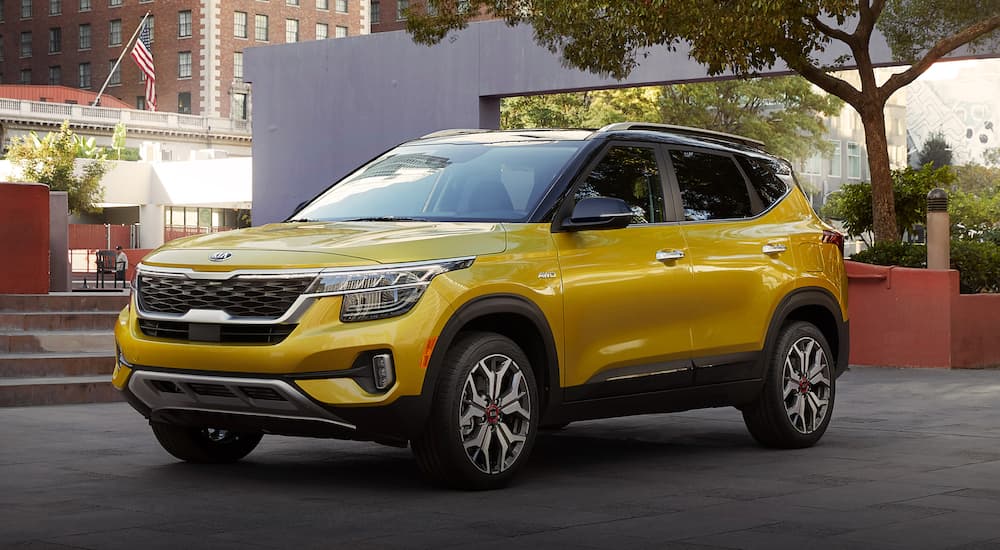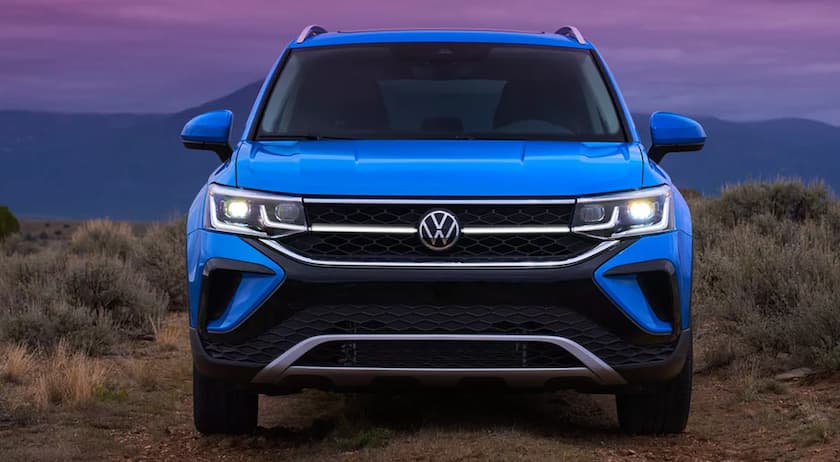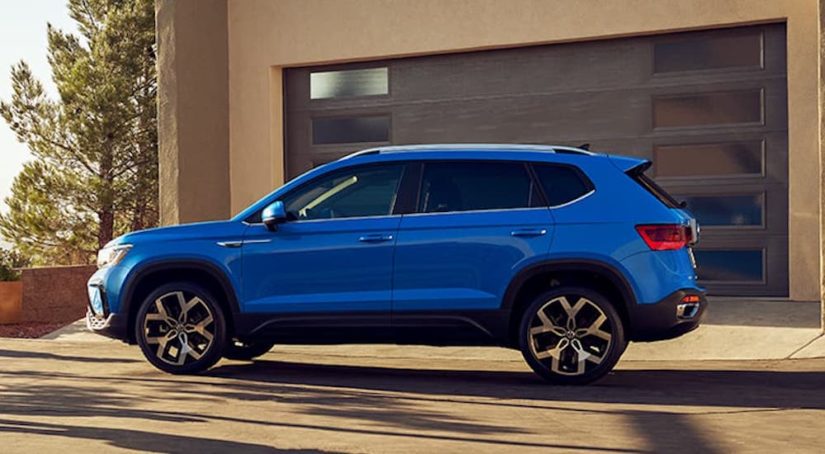Drivers frequently look for ways to save money, especially at the pump. However, we’re not often ready to sacrifice the spaciousness of a larger model for a more efficient and cramped alternative. This desire to have the best of both worlds has ignited fierce competition in the crossover segment. As a result, automakers promise to deliver sedan-like performance and efficiency on larger platforms with expansive cabins that provide ample room for passengers and cargo.
Is this too much to ask? Fortunately, it’s not, but it leads to another question: what does this race to build the right-sized SUV look like for two of the biggest rivals in the segment? Answering that requires slating the 2022 Volkswagen Taos vs 2022 Kia Seltos for an epic on-road battle to the finish line.
Start Your Engines: Performance
The 2022 Volkswagen Taos and 2022 Kia Seltos are both solid performers in a segment inundated with options. Volkswagen spares no expense in equipping the Taos with its proven 1.5L turbocharged engine that delivers 158 horsepower and 184 lb-ft of torque. The engine is remarkable, designed with variable geometric turbocharging that optimizes power without sacrificing efficiency. The result is more standard horsepower and less fuel consumption than what you’ll find on rivals like the Seltos.
So, where does that leave the Kia? The Seltos offers less capability from its standard powerplant: a 2.0L inline four-cylinder engine mated to a continuously variable transmission. The pairing delivers 146 horsepower and 132 lb-ft of torque. That’s 12 fewer horses and 52 lb-ft less torque, giving the Taos a significant advantage in off-the-line acceleration and pulling power for its standard engine option.

Drive Modes
The Taos also gains another advantage with its drive modes that allow you to harness the SUV’s power for the current terrain or condition. The Seltos gives you a choice between Normal, Individual, and Sport modes, tailoring each by fine tuning the suspension, steering, and power output. The Taos takes the approach one step further by giving drivers another level of customization with the SUV’s On-Road, Snow, and Off-Road modes.
The default On-Road Mode accounts for various road conditions by letting drivers choose between Normal, Sport, Eco, and Individual modes. Snow Mode engages the Traction Control System, minimizing wheel slippage in slippery conditions. With its custom option, the Off-Road Mode adds manual transmission control for improved performance on rugged terrain by fine tuning the gearbox, steering, and engine and engaging tools like Hill Descent and Hill Start Assist.
This expansive suite of drive modes gives the Taos a significant lead over the Seltos. It also proves the Taos engineers confidence in any condition, even off the pavement, by allowing the driver to customize the SUV’s performance based on the terrain. In contrast, the Seltos is limited to the road, leaving adventures for its more capable rival to enjoy.
Gas-Sipping in Tea Party Style: Fuel Economy
Any genuine tea party will have you sipping tea slowly with your pinkies up, which is akin to what you’ll find from the efficient Taos and Seltos in 2022. The SUVs are comparable in terms of efficiency, with each offering an incredible balance between power output and fuel consumption. However, the Taos delivers more horsepower and torque, making its fuel economy more impressive.
For example, the all-wheel drive Taos averages 25 MPG in the city and 32 MPG on the highway. Moreover, this efficiency comes with a power output of 184 lb-ft of torque and 158 horsepower, an outstanding balance by segment standards. On the other hand, the Seltos averages 27 MPG in the city and 31 MPG on the highway but only delivers 146 horsepower and 132 lb-ft of torque.
More for Your Money: Value
It takes Kia five trims to accomplish what Volkswagen does in three. The 2022 Taos lineup starts with the well-equipped S, which comes standard with the VW Digital Cockpit, LED headlights and taillights, keyless access with push-button start, and advanced driver-assist tools like Front Assist and blind-spot monitoring. The mid-level SE builds on these features, adding remote engine start, IQ.Drive, wireless charging, App Connect, and CloudTex seating surfaces. The top-tier SEL offers premium luxury and exclusive design details, from a panoramic sunroof and leather seating to BeatsAudio and the VW Digital Cockpit Pro.
The entry-level Seltos LX may cost less, but its standard features are fewer, with minimal technology beyond the center touchscreen display and automatic emergency braking. To enjoy the same level of luxury as the Taos requires spending more on a mid-tier trim like the EX or the top-tier SX. These trims add LED lighting and a premium sound system with several improvements to the SUV’s active and passive safety features, most of which come standard on the Taos and reflect how Volkswagen prioritizes every driver’s safety.
Room for More: Cargo Space
The Taos and Seltos prove how automakers take unique approaches to their vehicle designs. As subcompact SUVs, the Taos and Seltos share a similar platform, but Volkswagen relies on a functional design that enhances the cabin and optimizes passenger room and cargo space. You’ll see this firsthand in the rear cargo area, where the Taos offers 27.9 cubic feet of room with both rows in use or 65.9 cubic feet with the second row folded flat. In contrast, the Seltos’ interior is far more cramped, offering only 26.6 or 62.8 cubic feet, respectively.

Driving Made Easy: Driver-Assist Tech
Volkswagen is a pioneer in the automotive industry, renowned for quickly adopting new technology. On the 2022 Taos, this technology is centralized in IQ.Drive, a system of driver-assist tools that enhance your time in the driver’s seat. IQ.Drive, which is standard on the SEL and available on the S and SE, uses front and rear radar, sensors, and a front camera to gather data about the SUV’s position and traffic ahead. Then, it uses this data and tools like Travel Assist, Front Assist, the Active Blind Spot Monitor, Rear Traffic Alert, Adaptive Cruise Control, Stop and Go, Lane Assist, and Emergency Assist to help you navigate the road ahead with minimal input.
While IQ.Drive enriches every aspect of your experience, the Kia Drive Wise suite has more limitations and focuses solely on safety rather than driving ease or enhancement. For example, the suite includes blind spot monitoring, automatic emergency braking, lane keeping assist, a rear cross-traffic alert system, and a safe exit warning. However, it doesn’t offer anything comparable to or as extensive as Volkswagen IQ.Drive, which actively monitors what’s around the Taos to enhance your visibility, optimize your focus, minimize the potential for collision, and reduce driver fatigue by providing ongoing assistance as needed.
Arriving at the Finish Line
The 2022 Volkswagen Taos and the 2022 Kia Seltos both get a fair start at the beginning of the race. They’re subcompact SUVs that offer a two-row layout with ample room for passengers and numerous standard features. However, the Taos quickly takes the lead over its rival by proving that Volkswagen is more keenly attuned to what its drivers want and need when they’re behind the wheel.
Where the Volkswagen Taos offers customization, value, and innovation, the Kia Seltos falls short. The Taos not only delivers more standard horsepower and torque, but it’s more efficient and more capable, especially with an expansive lineup of drive modes that ensure the SUV performs as the terrain or condition demands. Unfortunately, this level of customization is practically non-existent in the Seltos, an SUV that offers a comparable fuel economy in terms of numbers until you look at its mediocre power output and what that means when trying to accelerate and maintain speed.
These factors give the 2022 Taos a clear advantage, which makes other factors like the Volkswagen IQ. Drive and Digital Cockpit more enticing. This cutting-edge technology ushers the Taos into a new era of innovation, keeping drivers connected and informed wherever the road leads. Together, these features and the SUV’s capable powertrain and dynamic performance make the Taos the clear winner in a fiercely competitive category where value, efficiency, and versatility reign.



